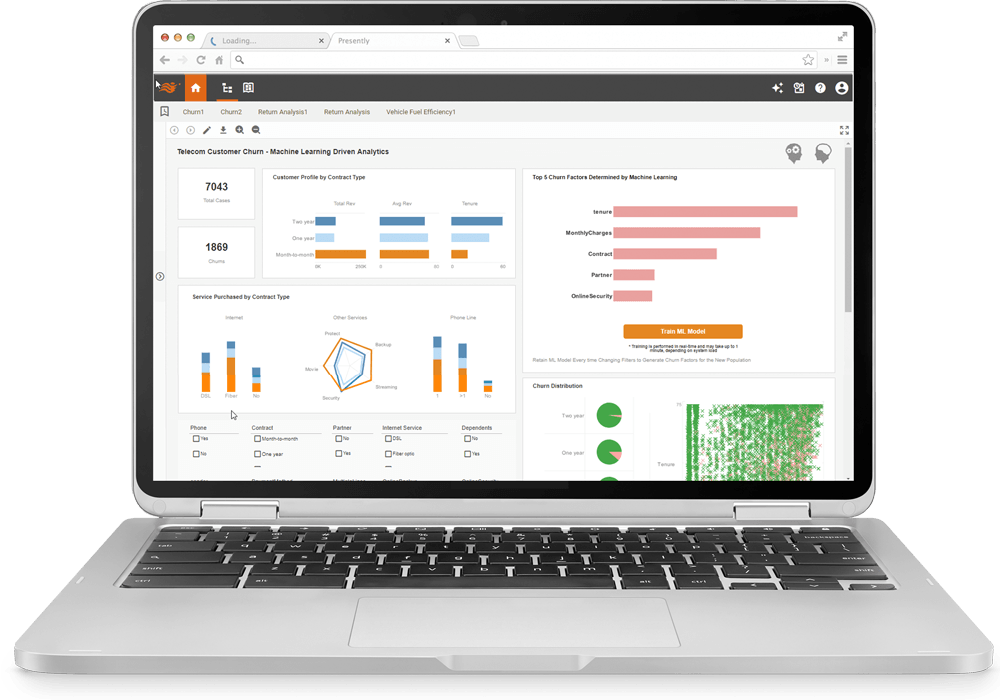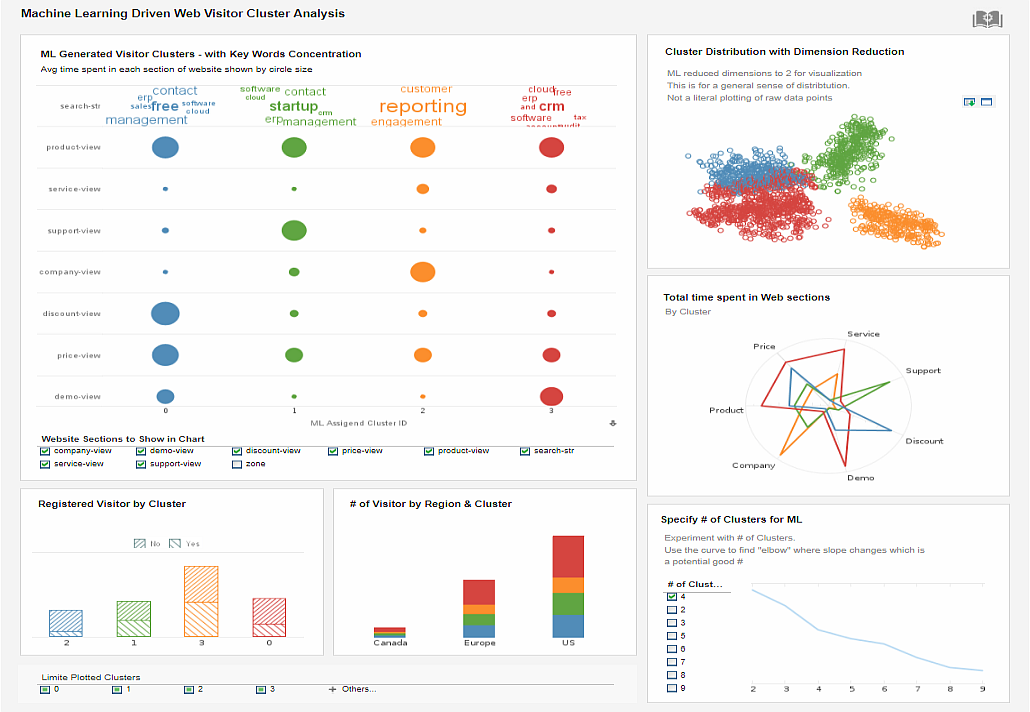Machine Learning
Machine learning extracts information from data that is not apparent to even experienced business users. Data scientists normally spearhead this process using specialized data science tools such as Python and R, but Business users are most times limited to static ML output and reports. InetSoft changes that.

Productionalize Machine Learning for Visual Analysis
InetSoft's data intelligence software productionalizes machine learning. It provides visual tools that directly tap into machine learning business applications. Business users can not only visually analyze machine learning results but also train machine learning models with sliced-and-diced data.
When data grows beyond an experimental machine learning setup, InetSoft's native Apache Spark based platform can easily scale on demand. It can utilize an external Spark Cluster or build its own with minimal Spark expertise.

Mashup Human and Machine Intelligence
Machine learning is a great new tool for many business applications. But just like other business data, it's most powerful when it is combined with other data and analysis.
InetSoft's data intelligence is based on a powerful mashup engine. With productionalized machine learning that business users can directly access, machine learning output can also be effortlessly mashed up with human designed analysis.
InetSoft Articles About Machine Learning
-
An Intro to Machine Learning and Some Examples
Explore the fundamentals of machine learning, including its necessity and real-world applications. The article discusses how machine learning can solve complex problems that traditional programming struggles with, such as object recognition and fraud detection. It emphasizes the importance of learning from examples to create effective machine learning models. Understanding these basics is crucial for leveraging machine learning in various business contexts.
-
Machine Learning Information Systems
Delve into the history and evolution of machine learning within information systems. The article distinguishes between machine learning and data mining, highlighting their complementary roles in data analysis. It discusses the challenges and advancements in scaling machine learning techniques to handle large datasets. Gaining insights into these aspects can enhance the implementation of machine learning in organizational data strategies.
-
Machine Learning Applications
Discover various machine learning algorithms and their applications in business contexts. The article covers supervised learning, where models are trained on labeled data, and unsupervised learning, which identifies patterns without predefined labels. It provides examples of how these techniques can be applied to tasks like customer segmentation and churn prediction. Understanding these applications can help businesses utilize machine learning to gain actionable insights.
-
Machine Learning Utilized For Predictive Analytics
Learn how machine learning enhances predictive analytics by forecasting outcomes and assessing probabilities. The article discusses the role of machine learning in identifying risks and opportunities within business operations. It highlights the integration of machine learning with big data and cognitive computing techniques to improve decision-making processes. Implementing these methods can lead to more accurate predictions and informed business strategies.
-
Machine Intelligence Program Information
Understand the steps involved in starting a machine learning project, from data preparation to model deployment. The article emphasizes the importance of integrating data from various sources and aligning organizational processes to support machine learning initiatives. It discusses the need for a feedback loop to assess the effectiveness of machine learning models. These insights can guide organizations in successfully implementing machine learning solutions.
-
Intro to Data Visualization and Machine Learning
Explore the synergy between data visualization and machine learning in enhancing data analysis. The article discusses how visualization techniques can aid in understanding data distributions and model performance. It highlights the use of tools like TensorFlow to visualize the machine learning process. Combining these approaches can lead to more effective data interpretation and decision-making.
-
Machine Learning Role Expands Business Intelligence
Examine how machine learning is transforming business intelligence by providing deeper insights and automation. The article discusses the integration of machine learning with business intelligence tools to enhance data analysis capabilities. It provides examples of organizations leveraging machine learning to gain a competitive edge. Embracing this integration can lead to more efficient and insightful business intelligence practices.
-
Machine Learning Technology Options
Learn about the various technology options available for implementing machine learning solutions. The article discusses the importance of selecting appropriate models and the role of data scientists in fine-tuning these models. It emphasizes the need for a robust data infrastructure to support machine learning initiatives. Understanding these options can help organizations choose the right tools for their machine learning projects.
-
Developers Using Machine Learning for Mobile Apps
Discover how developers are incorporating machine learning into mobile applications to enhance user experiences. The article discusses the benefits of using machine learning for tasks like trend identification and pattern analysis. It highlights the efficiency gains achieved by updating algorithms without extensive development time. These insights can guide developers in integrating machine learning into their mobile app development processes.
-
Machine Learning and Predictive Analytics Create Data to Analyze
Learn how machine learning and predictive analytics are creating new data types and enhancing data analysis capabilities. The article discusses the increasing variety of data sources and the importance of integrating these diverse data types. It emphasizes the role of machine learning in processing and analyzing complex data. Implementing these techniques can lead to more comprehensive and insightful data analysis.
